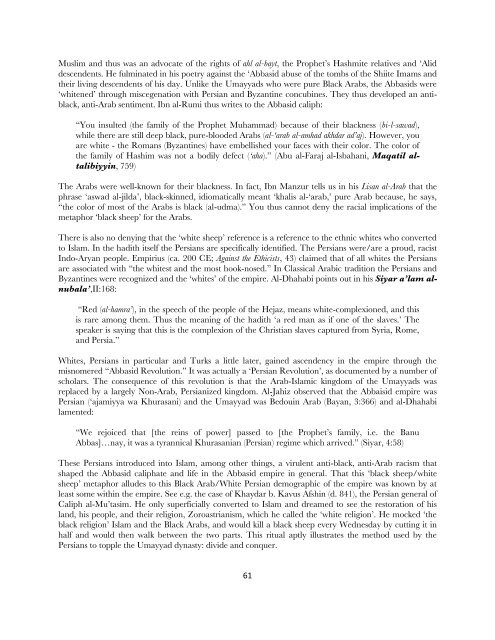Is THEM Guilty of Shirk? - Dr. Wesley Muhammad
Is THEM Guilty of Shirk? - Dr. Wesley Muhammad
Is THEM Guilty of Shirk? - Dr. Wesley Muhammad
Create successful ePaper yourself
Turn your PDF publications into a flip-book with our unique Google optimized e-Paper software.
Muslim and thus was an advocate <strong>of</strong> the rights <strong>of</strong> ahl al-bayt, the Prophet‘s Hashmite relatives and ‗Alid<br />
descendents. He fulminated in his poetry against the ‗Abbasid abuse <strong>of</strong> the tombs <strong>of</strong> the Shiite Imams and<br />
their living descendents <strong>of</strong> his day. Unlike the Umayyads who were pure Black Arabs, the Abbasids were<br />
‗whitened‘ through miscegenation with Persian and Byzantine concubines. They thus developed an antiblack,<br />
anti-Arab sentiment. Ibn al-Rumi thus writes to the Abbasid caliph:<br />
―You insulted (the family <strong>of</strong> the Prophet <strong>Muhammad</strong>) because <strong>of</strong> their blackness (bi-l-sawad),<br />
while there are still deep black, pure-blooded Arabs (al-„arab al-amhad akhdar ad‟aj). However, you<br />
are white - the Romans (Byzantines) have embellished your faces with their color. The color <strong>of</strong><br />
the family <strong>of</strong> Hashim was not a bodily defect („aha).‖ (Abu al-Faraj al-<strong>Is</strong>bahani, Maqatil altalibiyyin,<br />
759)<br />
The Arabs were well-known for their blackness. In fact, Ibn Manzur tells us in his Lisan al-Arab that the<br />
phrase ‗aswad al-jilda‘, black-skinned, idiomatically meant ‗khalis al-‗arab,‘ pure Arab because, he says,<br />
―the color <strong>of</strong> most <strong>of</strong> the Arabs is black (al-udma).‖ You thus cannot deny the racial implications <strong>of</strong> the<br />
metaphor ‗black sheep‘ for the Arabs.<br />
There is also no denying that the ‗white sheep‘ reference is a reference to the ethnic whites who converted<br />
to <strong>Is</strong>lam. In the hadith itself the Persians are specifically identified. The Persians were/are a proud, racist<br />
Indo-Aryan people. Empirius (ca. 200 CE; Against the Ethicists, 43) claimed that <strong>of</strong> all whites the Persians<br />
are associated with ―the whitest and the most hook-nosed.‖ In Classical Arabic tradition the Persians and<br />
Byzantines were recognized and the ‗whites‘ <strong>of</strong> the empire. Al-Dhahabi points out in his Siyar a’lam alnubala’,II:168:<br />
―Red (al-hamra‟), in the speech <strong>of</strong> the people <strong>of</strong> the Hejaz, means white-complexioned, and this<br />
is rare among them. Thus the meaning <strong>of</strong> the hadith ‗a red man as if one <strong>of</strong> the slaves.‘ The<br />
speaker is saying that this is the complexion <strong>of</strong> the Christian slaves captured from Syria, Rome,<br />
and Persia.‖<br />
Whites, Persians in particular and Turks a little later, gained ascendency in the empire through the<br />
misnomered ―Abbasid Revolution.‖ It was actually a ‗Persian Revolution‘, as documented by a number <strong>of</strong><br />
scholars. The consequence <strong>of</strong> this revolution is that the Arab-<strong>Is</strong>lamic kingdom <strong>of</strong> the Umayyads was<br />
replaced by a largely Non-Arab, Persianized kingdom. Al-Jahiz observed that the Abbaisid empire was<br />
Persian (‗ajamiyya wa Khurasani) and the Umayyad was Bedouin Arab (Bayan, 3:366) and al-Dhahabi<br />
lamented:<br />
―We rejoiced that [the reins <strong>of</strong> power] passed to [the Prophet‘s family, i.e. the Banu<br />
Abbas]…nay, it was a tyrannical Khurasanian (Persian) regime which arrived.‖ (Siyar, 4:58)<br />
These Persians introduced into <strong>Is</strong>lam, among other things, a virulent anti-black, anti-Arab racism that<br />
shaped the Abbasid caliphate and life in the Abbasid empire in general. That this ‗black sheep/white<br />
sheep‘ metaphor alludes to this Black Arab/White Persian demographic <strong>of</strong> the empire was known by at<br />
least some within the empire. See e.g. the case <strong>of</strong> Khaydar b. Kavus Afshin (d. 841), the Persian general <strong>of</strong><br />
Caliph al-Mu‘tasim. He only superficially converted to <strong>Is</strong>lam and dreamed to see the restoration <strong>of</strong> his<br />
land, his people, and their religion, Zoroastrianism, which he called the ‗white religion‘. He mocked ‗the<br />
black religion‘ <strong>Is</strong>lam and the Black Arabs, and would kill a black sheep every Wednesday by cutting it in<br />
half and would then walk between the two parts. This ritual aptly illustrates the method used by the<br />
Persians to topple the Umayyad dynasty: divide and conquer.<br />
61
















